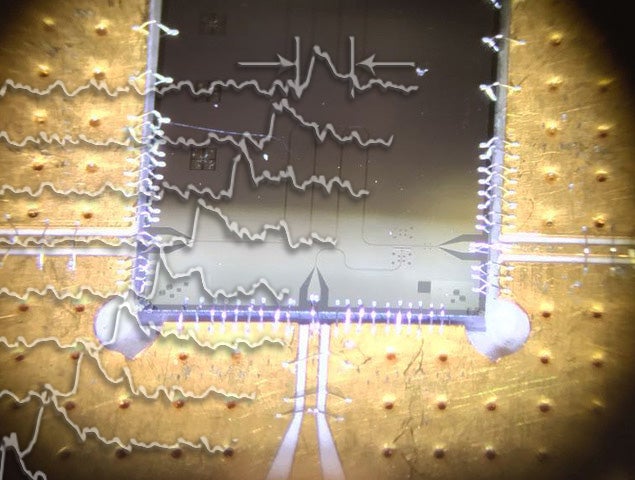Experiment finds way to increase photon efficiency for quantum communications
A team of researchers at the Institute for Quantum Computing (IQC) demonstrated a new type of on-demand single photon generator that can shape photons to increase their efficiency when used in a quantum network.
Next-generation communication networks will rely on the transmission of quantum information. Single photons, as carriers of quantum information, will play an integral role in building these future networks.
In a quantum network, a photon transmits quantum information most efficiently when it’s shape, or wave packet, matches the characteristics of the receiving node. That’s why researchers are investigating single photon generators – to build technologies that will produce the right photon shape, at the right time.
A recent experiment by the Engineered Quantum Systems Laboratory (EQSL) has demonstrated a simple device that achieves this. “Our results show an important proof-of-principle of an enabling technology for quantum networks, which is easily extensible to other types of physical systems beyond superconductors,” said Christopher Wilson, Principal Investigator.
The research group works with photons that are quantum states of microwave light. These photons operate at a microwave frequency of 5 GHz – the frequency of wireless communications. This means there is readily available technology at this frequency, allowing researchers to use electronic developments already established by industry.
The photon generator the team designed is a superconducting circuit comprised of two main parts. The first, a superconducting qubit, acts like an artificial atom that emits microwave light. The second is a superconducting transmission line that carries electrical signals through the circuit.

Image of the superconducting circuit used in the experiment. The overlay shows measured single-photon pulses.
Similar to a typical photon generator set-up, the artificial atom is placed in the transmission line. Once a resonant microwave pulse has excited the superconducting qubit, it emits single photons into the transmission line. The problem here becomes that the atom then sits in the transmission line in a fixed configuration, always emitting the photon in the same way – that is, with the same shape. In a quantum network, if the photon shape is different than that required by the receiving network node, efficiency is lost.
The researchers took a new approach to shaping the photons by manipulating quantum vacuum fluctuations on nanosecond timescales. Vacuum fluctuations are a disturbance in the transmission line caused by quantum effects in the electromagnetic field. They can cause energy decay and limit the coherence, or lifetime, of a qubit – in this case a superconducting artificial atom. In this setup, the disturbance caused by the vacuum fluctuations are also what drives the artificial atom to emit the photon into the transmission line.
By applying a magnetic field to a control circuit integrated in the transmission line, the researchers could move the quantum vacuum fluctuations in the line. As a result, they gained control over the emission of the atom and also the shape of the photons.
“The ability to produce shaped photons is important for good absorption of photon pulses by distant nodes of a quantum network,” said Wilson, also a professor in both the electrical and computer engineering and the physics and astronomy departments at the University of Waterloo. “This work further demonstrates how quantum microwaves are a resource for future quantum communication networks.”
The paper, On-Demand Microwave Generator of Shaped Single Photons, appeared in Physical Review Applied on November 8.